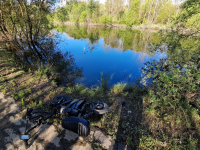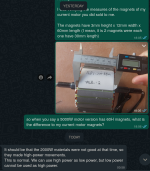How did u burn them? overheated? current surge?I burned this new again on his first 5 minutes!!
You are using an out of date browser. It may not display this or other websites correctly.
You should upgrade or use an alternative browser.
You should upgrade or use an alternative browser.
Fiido Q1S 2.5kW: VESC + modular DIY OpenSource electronics and software
- Thread starter casainho
- Start date
casainho
10 GW
- Joined
- Feb 14, 2011
- Messages
- 6,045
Sine I remember, yes. I did connect to the battery power without disabling the BMS switch.How did u burn them? overheated? current surge?
casainho
10 GW
- Joined
- Feb 14, 2011
- Messages
- 6,045
Hi, great project! How do you like the comfort on light offroad, in the forest or on gravel paths with these new tyres? Did you upgrade the suspension?
So yesterday I had to leave the car at the mechanic workshop for a week - the distance from my home is 25kms. So I decided to put the Fiido Q1S on the car and I returned home riding it. And I did easy secondary roads as also some gravel roads - this are places where I grow up. Was a nice sunny day, after various days of raining. I enjoyed a lot this ride!!
On the gravel roads, I felt comfortable to ride between 15 to 20kms/h.
I connected the motor temperature sensor to VESC and I found the motor was getting much more hot than I expected... I need to better understand all this, and I am afraid my VESC configurations are not so good at low speed / high currents, that may rise this issue of the motor getting to much hot.
I also implemented the Cruise Control feature and it works as expected. But I also did understand the throttle signal and a good amount of noise - I wish I can improve it.
I also found that I need a buzzer on the display, so like when Cruise Control starts, I can get a quick confirmation. The buzzer will also help on the turn signals.
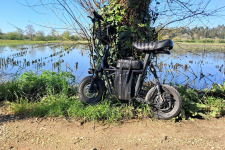
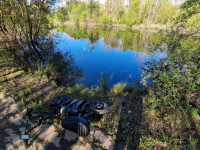
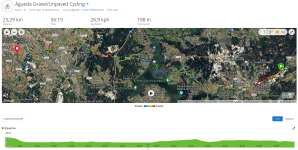
Attachments
casainho
10 GW
- Joined
- Feb 14, 2011
- Messages
- 6,045
I have a new issue to solve... I am trying to do longer rides, and sometimes even on more hilly terrain, but the motor heats a lot and stops to work.
The next pictures shows the Fiido Q1S on a train, on a nice early morning sunny Sunday, where I went to a distant place by train and then I did plan to go to a hilly place where I would run on a Trail Run event. But I didn't get there because the motor got very hot and lost power with that... - anyway, was a good experience transporting Fiido Q1S on the train, since it is way smaller than a regular bicycle. Then after, riding between the traditional villages is amazing because they are beautiful!!
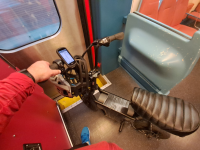
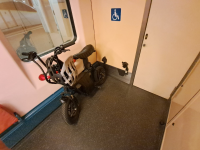
So, this is the motor inside, when was new:
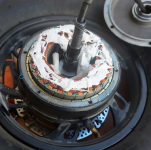
After that heating, I took this new picture. As you can see, the enamel coating of the coil wires, got liquid and went to that white part, also there are parts that are now brown instead of white. The bearing now has rust, because of the heating.

The motor still seems ok to me, but is more fragile now to more heating, as the copper wires lost some enamel so, more high heating's and they motor coils will short!!
So, because of this, I connected the temperature sensor to VESC - I didn't this before because I used my hand the feel the motor temperature and I always thought it was ok, but I was wrong...
Why I am having this issue now? well, because the previous motor had a different coils winding, it did run at high speed but had low torque. But this new motor version, the only difference is the rotor with a different coils winding, have 30% more torque and 30% less speed. BUT also, the coils resistance is now 70 ohms while previously were 30 ohms, so an increase of 233%!! and this increase was expected. So with a higher resistance comes and higher power losses in the form of heating....
What should I do next??
For now, I think I will reduce the motor torque / current but only at higher speeds, like I want to keep the torque but mainly for the startup and as soon a hit some speed, maybe like 25 kms/h, I may soft transition to a lower torque of -40% at my defined max speed of 55kms/h.
I may also later try to use a solution as Statorade, to help reduce the motor temperature, with max potential to reduce up to 40%.
The next pictures shows the Fiido Q1S on a train, on a nice early morning sunny Sunday, where I went to a distant place by train and then I did plan to go to a hilly place where I would run on a Trail Run event. But I didn't get there because the motor got very hot and lost power with that... - anyway, was a good experience transporting Fiido Q1S on the train, since it is way smaller than a regular bicycle. Then after, riding between the traditional villages is amazing because they are beautiful!!


So, this is the motor inside, when was new:

After that heating, I took this new picture. As you can see, the enamel coating of the coil wires, got liquid and went to that white part, also there are parts that are now brown instead of white. The bearing now has rust, because of the heating.

The motor still seems ok to me, but is more fragile now to more heating, as the copper wires lost some enamel so, more high heating's and they motor coils will short!!
So, because of this, I connected the temperature sensor to VESC - I didn't this before because I used my hand the feel the motor temperature and I always thought it was ok, but I was wrong...
Why I am having this issue now? well, because the previous motor had a different coils winding, it did run at high speed but had low torque. But this new motor version, the only difference is the rotor with a different coils winding, have 30% more torque and 30% less speed. BUT also, the coils resistance is now 70 ohms while previously were 30 ohms, so an increase of 233%!! and this increase was expected. So with a higher resistance comes and higher power losses in the form of heating....
What should I do next??
For now, I think I will reduce the motor torque / current but only at higher speeds, like I want to keep the torque but mainly for the startup and as soon a hit some speed, maybe like 25 kms/h, I may soft transition to a lower torque of -40% at my defined max speed of 55kms/h.
I may also later try to use a solution as Statorade, to help reduce the motor temperature, with max potential to reduce up to 40%.
SlowCo
1 MW
Great little bike! I suspect the StatorAde will help a lot. Next step will be a bigger diameter motor.
casainho
10 GW
- Joined
- Feb 14, 2011
- Messages
- 6,045
About the motor, if I can find one that is more powerful, with more torque and more power, so I can use on hills... or maybe go with dual motors...Great little bike! I suspect the StatorAde will help a lot. Next step will be a bigger diameter motor.
SlowCo
1 MW
I don't know what the drop out width of the bike is and what size tire will fit but maybe one of the QS hub motor with rims is a match?
QS moped motor
QS moped motor
Last edited:
The stuff on the white silicone is almost certainly not the enamel, but just rust,etc.After that heating, I took this new picture. As you can see, the enamel coating of the coil wires, got liquid and went to that white part, also there are parts that are now brown instead of white. The bearing now has rust, because of the heating.
If it was the enamel, the windings would be shorted together without it, and the motor would not operate and your controller would smell funny.
Heating doesn't cause the rust, but water intrusion does, and also would let it be deposited onto the silicone as the motor rotates.
Then heating would dry out the water, leaving the rust deposits attached to whatever they dried on.
Sufficient heating can certain "cook" the enamel, leaving a burned-circuit-board smell in the motor and darkening the enamel color. I don't see a difference in color of the windings between the two images, but the lighting isn't identical nor is the angle, so there could be a difference simply not shown there.
Only if the current thru them is still the same. Do you still get identical phase currents? If not, and the currents are now proportionally lower, then heating should be about the same as well.So with a higher resistance comes and higher power losses in the form of heating....
How hot does the motor get? It has to be very hot to cook the winding insulation off (burning it); if you have hall sensors then they will probably stop working correctly before those temperatures are reached. If they don't get too hot they may recover when cooled down, but while that hot they are unlikely to operate at all, or at least not as designed.
Long ago I overheated a Fusin "350w" geared hubmotor repeatedly to the point the halls would stop working, have to stop and pour water on the motor casing until it cooled enough to ride again, and the windings didn't cook. At some point during one or more of these events the solder holding SMT caps/resistors on the hall board actually melted and tiny parts came loose...but the windings were still good, though eventually I broke the clutch on the motor at startup from a stop.
casainho
10 GW
- Joined
- Feb 14, 2011
- Messages
- 6,045
It is a 12 inches motor. The motor dropouts internal distance is 125mm. The tires can be like 12x3.00 or 12x3.50.I don't know what the drop out width of the bike is and what size tire will fit but maybe one of the QS hub motor with rims is a match?
QS moped motor
I need to look at that QS motors. For now I am looking at this ones - because they have 40 magnets and mine have 30, so I expect 33% more torque(??). And it is a rim split, meaning it will be way easier to install the strong good quality tires!!
Name: 12 inch Split Hub Motor
Voltage: 48v 60v 72v
Power: 1500w 2000w 3500w 5000w
Speed: 48v1500w: 55-60km/h; 48v60v2000w: 60-80km/h 60v72v3500w: 60-90km/h; 60v72v5000w: 90-120km/h
Max torque: 60N.m
Magnet poles: 20
Magnet steel height: 30H
Open size: 121mm
Axle length: 201mm
Tyre model: 62-203 (12½x2)

casainho
10 GW
- Joined
- Feb 14, 2011
- Messages
- 6,045
Only if the current thru them is still the same. Do you still get identical phase currents? If not, and the currents are now proportionally lower, then heating should be about the same as well.
How hot does the motor get? It has to be very hot to cook the winding insulation off (burning it); if you have hall sensors then they will probably stop working correctly before those temperatures are reached. If they don't get too hot they may recover when cooled down, but while that hot they are unlikely to operate at all, or at least not as designed.
Yes, I keep the same current, because I needed more torque comparing to previous motor. I was not aware of the resistance increase.
A search on google:
Does temperature cause rust?

An increase in temperature contributes to an increase in the number of active centers of corrosion on the metal surface and accelerates the development of corrosion processes; therefore, it is necessary to provide the protection of metal products, equipment and structures operating at elevated temperatures.
Heat can certainly *accelerate* rust...but there has to be something in there to help that happen. Just the oxygen in the small amount of air trapped inside the motor (or even an actively-ventilated one) is not usually sufficient, especially over a short time scale like you've had. High humidity, or actual pooled water, is much more effective, especially if you have salted roads in winter (even if they aren't salted when you ride, it's still in the road surface and still contaminates the rainwater on it).
In hubmotors, the kind of rust you see in your pics there is always (in my experience so far, and that of other posters here) caused by water intrusion, usually thru the bearing seals or motor wiring / wiring channel in the axle, etc.
In hubmotors, the kind of rust you see in your pics there is always (in my experience so far, and that of other posters here) caused by water intrusion, usually thru the bearing seals or motor wiring / wiring channel in the axle, etc.
casainho
10 GW
- Joined
- Feb 14, 2011
- Messages
- 6,045
I didn't use this scooter / motor in rain... but, I live near the ocean and there is a lot of humidity!!!Heat can certainly *accelerate* rust...but there has to be something in there to help that happen. Just the oxygen in the small amount of air trapped inside the motor (or even an actively-ventilated one) is not usually sufficient, especially over a short time scale like you've had. High humidity, or actual pooled water, is much more effective, especially if you have salted roads in winter (even if they aren't salted when you ride, it's still in the road surface and still contaminates the rainwater on it).
In hubmotors, the kind of rust you see in your pics there is always (in my experience so far, and that of other posters here) caused by water intrusion, usually thru the bearing seals or motor wiring / wiring channel in the axle, etc.
I didn't use this scooter / motor in rain... but, I live near the ocean and there is a lot of humidity!!!
And salt in the humid air, most likely, which will also accelerate corrosion.
So....I'd still call ths one a simple rusting problem, and not a heating issue. (not that it isn't getting hot,, just that ot doesn't seem to be damaged from it at this point)
You may have higher heat, but I don't see damage from heat in the images so far, just the corrosion. (which being metallic, could cause other operational problems if it gets in the wrong places).
Bearing corrosion will make the wheel harder to turn, so take more power to spin, so create more heat...but a serious bearing problem to take serious power to overcome would be easy to tell is happening when trying to spin the motor by hand....
I'd replace the bearings, and pack them with grease, and pack grease between them and the seal rings on the outside. (if there aren't any seal rings outside the bearings, I'd add some).
You can also seal up the motor internally against corrosion with various coatings, once it's completely clean of any salt, humidity, or corrosion. There's a number of threads about that sort of thing, such as Kingfish's old thread about DIY Rust and Restoration (not sure of the exact title).
If you need to replace the motor with one more able to provide and handle the power you need for the riding conditions you have, I'd recommend doing those sealing/greasing mods before using it, to keep the humidity/salt out of it to start with.
2WD will help by spreading the heat generated across two motors, but it's a little less efficient as you have the extra weight of the other motor and controller. But it's also redundant so if you ahve a failure you can still at least limp home on the other one.
That's how I've setup both my successful cargo bikes (well, one bike and one trike), CrazyBike2 and SB Cruiser.
Last edited:
casainho
10 GW
- Joined
- Feb 14, 2011
- Messages
- 6,045
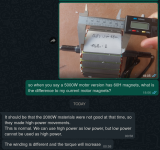
I found and confirmed with the seller, that my motor is in fact the 5000W version and not the 2000W version I bought!! But since I asked for a custom winding to have more torque and lower speed, she is saying if I buy another motor but this time for 72V, it will have more torque. However, I found online that the dual motor phase wires version, like mine, is for 60V and 72V motor versions!!
So, probably I have the 72V 5000W motor version. The seller also told me that this motor version should have about 80N.m.
So, to resume, my current motor should be 72V 5000W, has 30 magnets of 60H, no load speed of 1230RPM / 70km/h at 72V battery, and the phase wires are 4mm2 (2mm2 each wires, 2 wires for each phase).
And I was looking to buy this different motor, that everyone says has a strong torque - but I wounder how can I know before I buy it.
The data I have about it:
72V 5000W, 40 magnets of 30H, no load speed of 1600RPM at 72V battery and 6mm2 phase wires.
Anyone knows what should I expect, compared to my actual motor??

What I like on this motor is the is the split rim, since it is very easy to install and remove any thick tire like this one:
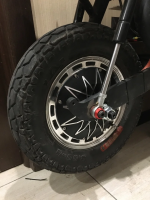
Attachments
Last edited:
casainho
10 GW
- Joined
- Feb 14, 2011
- Messages
- 6,045
I am limiting the motor phase current to 135 amps and I see the motor getting hot relatively quick. The seller told me this is a 2000W motor and the max motor phase current should be 80A.
Today I tested the motor for the first time using the VESC foc_openloop 80 1000, that rotates the motor at 1000 ERPM (wheel speed = 4kms/h) and forces a motor current of 80 amps. But if the motor hits near the max temperature, the motor current will be reduced automatically to keep the temperature at a safe value.
So after a few minutes, with 13ºC ambient temperature, the motor stabilized at 90ºC with a motor current of only 27 amps. The battery voltage was 74V and battery current was only 1.46 amps, with a power usage of only 110 Watts!! -- this data is registered on the next graphs recorded from VESC.
So, if riding my motor, it will get hot up to a point that it can only run at 110 watts?? is there anything wrong with my motor or are this regular values??
@amberwolf
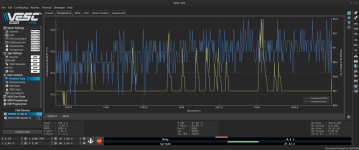
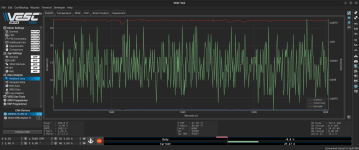
Today I tested the motor for the first time using the VESC foc_openloop 80 1000, that rotates the motor at 1000 ERPM (wheel speed = 4kms/h) and forces a motor current of 80 amps. But if the motor hits near the max temperature, the motor current will be reduced automatically to keep the temperature at a safe value.
So after a few minutes, with 13ºC ambient temperature, the motor stabilized at 90ºC with a motor current of only 27 amps. The battery voltage was 74V and battery current was only 1.46 amps, with a power usage of only 110 Watts!! -- this data is registered on the next graphs recorded from VESC.
So, if riding my motor, it will get hot up to a point that it can only run at 110 watts?? is there anything wrong with my motor or are this regular values??
@amberwolf


I am limiting the motor phase current to 135 amps and I see the motor getting hot relatively quick. The seller told me this is a 2000W motor and the max motor phase current should be 80A.
Well, if you're running 135A thru something that only takes 80A, I'd expect it to get hot pretty quick.
What's the actual continuous phase amps during an actual ride when it's getting hot? (if you said, I missed it)
If you're only peaking those levels every so often it wouldn't be such a big deal, but doing it a lot or for more than a few seconds at a time is probably going to build up heat pretty quick.
I don't know how the VESC does that test / mode, so I can't say why it is doing what it's doing there.
But...any test that doesn't have a physical load on the motor to create the current demand by it seems that it would not be a real-world type of test, and it's results might not be applicable to actual usage. I don't know enough about how such a test might actually be done without a physical load , by only the controller, to even guess.
The main things I've seen heat up motors that shouldn't for the given power level are running them with poorly-tuned controllers vs the motor design, and running them under loads that the kV they have doesn't support for the speed they're being driven at.
The former is certainly fixable with a VESC, although I have no experience at all with tuning one.
The latter just means that if the motor's loaded RPM at the given battery voltage and controller-output-level is too low, compared to the RPM it would have unloaded in the same inputs, there won't be enough BEMF to counter the current into the motor, and it will heat up more than it should. (you probably already know all this, but if not, play with the ebikes.ca simulator with any of the thermally-modelled motors in various setups to force this to happen, and you can see it in the charted results).
This specific example isn't directly applicable to an FOC contorller as they modulate torque, not speed, but it should get the idea across (I can't presently think how to state an example for an FOC, but there is a way): For instance, if the motor's unloaded speed at say, 50% throttle, is 500RPM, but loaded down it drops to 100RPM at 50% throttle, the current will be say, 5x higher than it "should" be. (realistically loaded is usually around 80% of unloaded RPM, so it *should* be around 400RPM, so current is really only 4x higher than it should be). But that means it heats up proportionally faster than it would if it were able to run at the speed it should.
I'm not sure if that makes any sense...I'm too tired to continue the thought, though.
Last edited:
casainho
10 GW
- Joined
- Feb 14, 2011
- Messages
- 6,045
As my motor is heating a lot (at least much more than what I expected, but I may be wrong), I improved the firmware, to keep the highest motor current (135 amps - 0 kms/h speed) at start and then reduce it linearly up to 40 amps and keep that value afterwards (40 amps - after 30 kms/h).
I also added an option for speed control were regen current is 0 amps, so I could coast - as regen also heats the motor!
Then I also updated the the current control mode. In the end, I ended up using the current control mode as I could modulate the current with the throttle and so avoid big spikes in current, to reduce motor heating.
I did on Sunday a ride of 50 kms, mostly flat. I found that motor temperature did stabilize like at 75 degrees, with a 35 or 40 amps motor current. That was is a low torque for me, did work only because was flat roads.
Next step is to try figure out if my motor magnets are a bit bad already - I have the other equal motor but with different winding, let's see if I can compare them.
I need to add a few custom UART commands to VESC firmware, but latter I need to implement them with VESC own scripting language to avoid to have a custom VESC firmware.
The main update on the Python firmware, running on the main board ESP32-S3, to control the scooter:
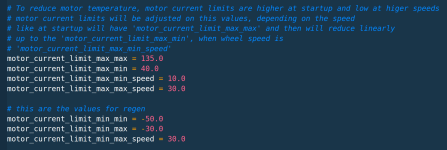
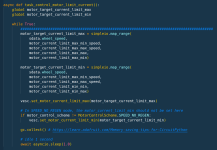
I also added an option for speed control were regen current is 0 amps, so I could coast - as regen also heats the motor!
Then I also updated the the current control mode. In the end, I ended up using the current control mode as I could modulate the current with the throttle and so avoid big spikes in current, to reduce motor heating.
I did on Sunday a ride of 50 kms, mostly flat. I found that motor temperature did stabilize like at 75 degrees, with a 35 or 40 amps motor current. That was is a low torque for me, did work only because was flat roads.
Next step is to try figure out if my motor magnets are a bit bad already - I have the other equal motor but with different winding, let's see if I can compare them.
I need to add a few custom UART commands to VESC firmware, but latter I need to implement them with VESC own scripting language to avoid to have a custom VESC firmware.
The main update on the Python firmware, running on the main board ESP32-S3, to control the scooter:


Similar threads
- Replies
- 3
- Views
- 2,008
- Replies
- 4
- Views
- 765
- Replies
- 5
- Views
- 958
- Replies
- 23
- Views
- 3,580
- Replies
- 3
- Views
- 691


